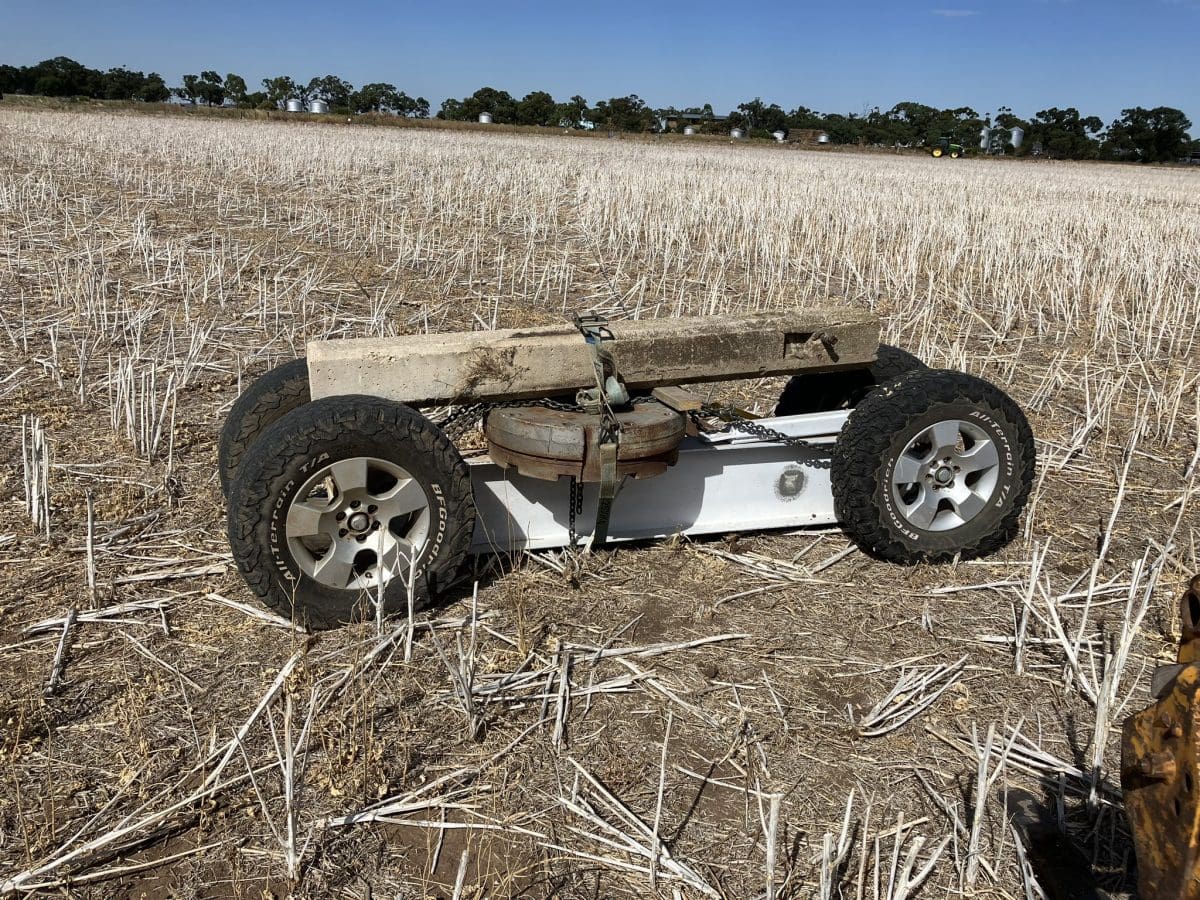
The reworked Mad Rabbit, which includes a concrete gatepost to keep the unit travelling beside instead of behind the tractor. Photo: Kyle Pearse
THE wet season of 2022 has brought with it record or near-record yields for many Australian growers, but at a cost.
The most significant is disease pressure, and for many in Victoria, South Australia and Western Australia, snails are in there too.
Inspired by a similar technique created by a neighbour, Victorian grower Kyle Pearse has come up with an ingenious way to control the burgeoning snail population on his family’s farm at Donald in the Southern Mallee region.
Rabbit to the rescue
A section of I-beam with four wheels attached was the prototype for the Mad Rabbit.
“It’s pretty cheap and it’s pretty fast; it’ll go over 300ha in an hour,” Mr Pearse said.
Best used on a very warm to hot day, when snails climb up stubble to get away from the heat of the ground, the Mad Rabbit cruises 109m out from a tractor travelling at 30km/h.
“It seems to be 95 percent effective and if you do it twice, 100pc.”
While a number of farming operations use a cable dragged between two tractors, the Mad Rabbit can be put to use with one operator.
Mr Pearse said towing it has taken some getting used to.
“It’s a bit wild.
“It turns really slowly one way, and what works best is going round and round in a big circle.”
So, snails have become a bit of a drama here in recent years. It’s a work in progress, but this “mad rabbit” at 109 meters wide and 30km/h deals with them swiftly and effectively on a warm day. One man operation. 😎 credit to an exceptionally innovative neighbour for the concept! pic.twitter.com/z8XZZIw6Pa
— Kyle Pearse (@pearse_kyle) February 17, 2023
It had its maiden run two weeks ago, and is being used on cereal and canola stubble.

The Mad Rabbit Mk I ran behind instead of beside the tractor, and went back to the workshop for modificiation. Photo: Kyle Pearse
“I made it look beautiful to start with, and painted it up, and then found it didn’t go away from behind the tractor.
“It had to come into the workshop five or six times.”
A concrete gate post has provided the ballast needed to keep the Mad Rabbit to the side instead of the rear of the tractor, and running along every third controlled-traffic line.
The Pearses grow barley, canola, faba beans, lentils, oats, vetch and wheat, and expect to start sowing next month with oats and vetch for sheep feed.
Mr Pearse said he plans to do only around 500ha of their farming country with the Mad Rabbit.
Snail’s pace accelerates
Grain Trade Australia receival standards have no tolerance for live snails, and minimal tolerance for fragments of snail shell.
It means growers need to get on top of snails using one or more of three methods as outlined in Grains Research and Development Corporation publications: baiting them, bashing them off stubble, or burning their stubble habitat.
GRDC advises baiting is ideally done in late summer or early autumn for maximum efficacy, and to avoid residue issues in harvested grain.

Snails on canola stubble are a prime target for the Mad Rabbit. Photo: Kyle Pearse
Burning stubble in autumn is also effective, but can impact soil-organic matter and soil water, and increase the risk of erosion.
Rolling or cabling stubble, which knocks snails on to hot soil, is another effective method, and the one preferred by Mr Pearse and his neighbour.
“With bashing, we’re trying to be as fast and efficient as we can.”
“Snails have become a bit of a drama here in recent years.”
“They’re getting progressively worse.
“They only started to be an issue in the area in the past five years, and canola is the really bad one.”
“We don’t want them to become a bigger issue.”
Mr Pearse said disused infrastructure, as well as a couple of wet seasons, appear to be playing a part in expediting their spread.
The Wimmera Mallee Domestic and Stock Channel System was built from the late 1800s to the the 1960s, and covered 2.9 million hectares of north-west Victoria via 17,500km of earthen channels.
Due to unacceptably high evaporation losses, a section of it has been replaced with the Wimmera Mallee Pipeline.
While government funded the decommissioning of large channels by 2014 , the decommissioning of smaller channels has been left up to landholders.
Mr Pearse believes recent wet seasons, with the channels as a haven, have helped snails proliferate.
“We’ve had three quite above-average seasons in a row.
“We’ve got problematic paddocks that they’re in every year, and it has to do with their location in relation to the channels.”
Sparkeag principal Matthew Sparke is based at Horsham in the Victorian Wimmera, and said slugs as well as snails will be “big” after the prolonged wet, with canola particularly popular among the gastropods.
He said wet and mild conditions have seen slugs and snails advance from the perimeter of the paddock to its midst, with canola being their favourite crop.
“In the past year, they’ve moved a fair bit, and gone from the fence lines into the full paddock.”
Gastropods tend to be an issue on alkaline rather than acid soils, and have for many years required management on carbonate soil types.
Mr Sparke said liming programs may be encouraging their spread.
“They like the calcium.”
Grain Central: Get our free news straight to your inbox – Click here

HAVE YOUR SAY